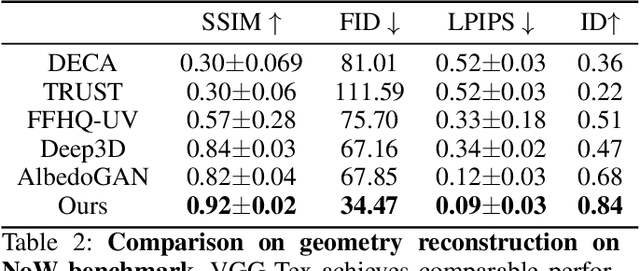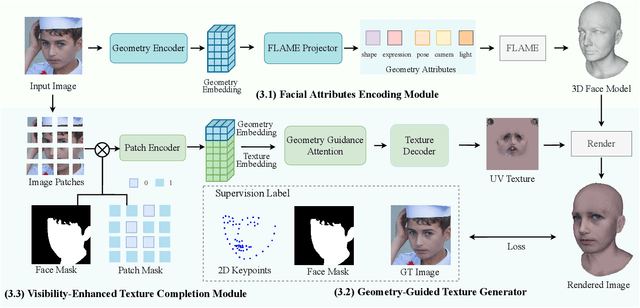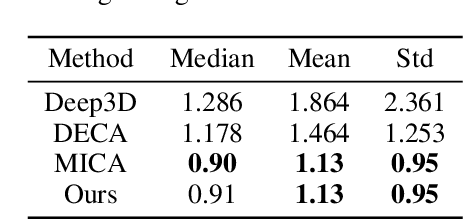Ziqiao Peng
Morpheus: A Neural-driven Animatronic Face with Hybrid Actuation and Diverse Emotion Control
Jul 22, 2025Abstract:Previous animatronic faces struggle to express emotions effectively due to hardware and software limitations. On the hardware side, earlier approaches either use rigid-driven mechanisms, which provide precise control but are difficult to design within constrained spaces, or tendon-driven mechanisms, which are more space-efficient but challenging to control. In contrast, we propose a hybrid actuation approach that combines the best of both worlds. The eyes and mouth-key areas for emotional expression-are controlled using rigid mechanisms for precise movement, while the nose and cheek, which convey subtle facial microexpressions, are driven by strings. This design allows us to build a compact yet versatile hardware platform capable of expressing a wide range of emotions. On the algorithmic side, our method introduces a self-modeling network that maps motor actions to facial landmarks, allowing us to automatically establish the relationship between blendshape coefficients for different facial expressions and the corresponding motor control signals through gradient backpropagation. We then train a neural network to map speech input to corresponding blendshape controls. With our method, we can generate distinct emotional expressions such as happiness, fear, disgust, and anger, from any given sentence, each with nuanced, emotion-specific control signals-a feature that has not been demonstrated in earlier systems. We release the hardware design and code at https://github.com/ZZongzheng0918/Morpheus-Hardware and https://github.com/ZZongzheng0918/Morpheus-Software.
GGTalker: Talking Head Systhesis with Generalizable Gaussian Priors and Identity-Specific Adaptation
Jun 26, 2025Abstract:Creating high-quality, generalizable speech-driven 3D talking heads remains a persistent challenge. Previous methods achieve satisfactory results for fixed viewpoints and small-scale audio variations, but they struggle with large head rotations and out-of-distribution (OOD) audio. Moreover, they are constrained by the need for time-consuming, identity-specific training. We believe the core issue lies in the lack of sufficient 3D priors, which limits the extrapolation capabilities of synthesized talking heads. To address this, we propose GGTalker, which synthesizes talking heads through a combination of generalizable priors and identity-specific adaptation. We introduce a two-stage Prior-Adaptation training strategy to learn Gaussian head priors and adapt to individual characteristics. We train Audio-Expression and Expression-Visual priors to capture the universal patterns of lip movements and the general distribution of head textures. During the Customized Adaptation, individual speaking styles and texture details are precisely modeled. Additionally, we introduce a color MLP to generate fine-grained, motion-aligned textures and a Body Inpainter to blend rendered results with the background, producing indistinguishable, photorealistic video frames. Comprehensive experiments show that GGTalker achieves state-of-the-art performance in rendering quality, 3D consistency, lip-sync accuracy, and training efficiency.
SyncTalk++: High-Fidelity and Efficient Synchronized Talking Heads Synthesis Using Gaussian Splatting
Jun 17, 2025Abstract:Achieving high synchronization in the synthesis of realistic, speech-driven talking head videos presents a significant challenge. A lifelike talking head requires synchronized coordination of subject identity, lip movements, facial expressions, and head poses. The absence of these synchronizations is a fundamental flaw, leading to unrealistic results. To address the critical issue of synchronization, identified as the ''devil'' in creating realistic talking heads, we introduce SyncTalk++, which features a Dynamic Portrait Renderer with Gaussian Splatting to ensure consistent subject identity preservation and a Face-Sync Controller that aligns lip movements with speech while innovatively using a 3D facial blendshape model to reconstruct accurate facial expressions. To ensure natural head movements, we propose a Head-Sync Stabilizer, which optimizes head poses for greater stability. Additionally, SyncTalk++ enhances robustness to out-of-distribution (OOD) audio by incorporating an Expression Generator and a Torso Restorer, which generate speech-matched facial expressions and seamless torso regions. Our approach maintains consistency and continuity in visual details across frames and significantly improves rendering speed and quality, achieving up to 101 frames per second. Extensive experiments and user studies demonstrate that SyncTalk++ outperforms state-of-the-art methods in synchronization and realism. We recommend watching the supplementary video: https://ziqiaopeng.github.io/synctalk++.
OmniSync: Towards Universal Lip Synchronization via Diffusion Transformers
May 27, 2025Abstract:Lip synchronization is the task of aligning a speaker's lip movements in video with corresponding speech audio, and it is essential for creating realistic, expressive video content. However, existing methods often rely on reference frames and masked-frame inpainting, which limit their robustness to identity consistency, pose variations, facial occlusions, and stylized content. In addition, since audio signals provide weaker conditioning than visual cues, lip shape leakage from the original video will affect lip sync quality. In this paper, we present OmniSync, a universal lip synchronization framework for diverse visual scenarios. Our approach introduces a mask-free training paradigm using Diffusion Transformer models for direct frame editing without explicit masks, enabling unlimited-duration inference while maintaining natural facial dynamics and preserving character identity. During inference, we propose a flow-matching-based progressive noise initialization to ensure pose and identity consistency, while allowing precise mouth-region editing. To address the weak conditioning signal of audio, we develop a Dynamic Spatiotemporal Classifier-Free Guidance (DS-CFG) mechanism that adaptively adjusts guidance strength over time and space. We also establish the AIGC-LipSync Benchmark, the first evaluation suite for lip synchronization in diverse AI-generated videos. Extensive experiments demonstrate that OmniSync significantly outperforms prior methods in both visual quality and lip sync accuracy, achieving superior results in both real-world and AI-generated videos.
DualTalk: Dual-Speaker Interaction for 3D Talking Head Conversations
May 26, 2025Abstract:In face-to-face conversations, individuals need to switch between speaking and listening roles seamlessly. Existing 3D talking head generation models focus solely on speaking or listening, neglecting the natural dynamics of interactive conversation, which leads to unnatural interactions and awkward transitions. To address this issue, we propose a new task -- multi-round dual-speaker interaction for 3D talking head generation -- which requires models to handle and generate both speaking and listening behaviors in continuous conversation. To solve this task, we introduce DualTalk, a novel unified framework that integrates the dynamic behaviors of speakers and listeners to simulate realistic and coherent dialogue interactions. This framework not only synthesizes lifelike talking heads when speaking but also generates continuous and vivid non-verbal feedback when listening, effectively capturing the interplay between the roles. We also create a new dataset featuring 50 hours of multi-round conversations with over 1,000 characters, where participants continuously switch between speaking and listening roles. Extensive experiments demonstrate that our method significantly enhances the naturalness and expressiveness of 3D talking heads in dual-speaker conversations. We recommend watching the supplementary video: https://ziqiaopeng.github.io/dualtalk.
MEGADance: Mixture-of-Experts Architecture for Genre-Aware 3D Dance Generation
May 23, 2025Abstract:Music-driven 3D dance generation has attracted increasing attention in recent years, with promising applications in choreography, virtual reality, and creative content creation. Previous research has generated promising realistic dance movement from audio signals. However, traditional methods underutilize genre conditioning, often treating it as auxiliary modifiers rather than core semantic drivers. This oversight compromises music-motion synchronization and disrupts dance genre continuity, particularly during complex rhythmic transitions, thereby leading to visually unsatisfactory effects. To address the challenge, we propose MEGADance, a novel architecture for music-driven 3D dance generation. By decoupling choreographic consistency into dance generality and genre specificity, MEGADance demonstrates significant dance quality and strong genre controllability. It consists of two stages: (1) High-Fidelity Dance Quantization Stage (HFDQ), which encodes dance motions into a latent representation by Finite Scalar Quantization (FSQ) and reconstructs them with kinematic-dynamic constraints, and (2) Genre-Aware Dance Generation Stage (GADG), which maps music into the latent representation by synergistic utilization of Mixture-of-Experts (MoE) mechanism with Mamba-Transformer hybrid backbone. Extensive experiments on the FineDance and AIST++ dataset demonstrate the state-of-the-art performance of MEGADance both qualitatively and quantitatively. Code will be released upon acceptance.
ModelGrow: Continual Text-to-Video Pre-training with Model Expansion and Language Understanding Enhancement
Dec 25, 2024Abstract:Text-to-video (T2V) generation has gained significant attention recently. However, the costs of training a T2V model from scratch remain persistently high, and there is considerable room for improving the generation performance, especially under limited computation resources. This work explores the continual general pre-training of text-to-video models, enabling the model to "grow" its abilities based on a pre-trained foundation, analogous to how humans acquire new knowledge based on past experiences. There is a lack of extensive study of the continual pre-training techniques in T2V generation. In this work, we take the initial step toward exploring this task systematically and propose ModelGrow. Specifically, we break this task into two key aspects: increasing model capacity and improving semantic understanding. For model capacity, we introduce several novel techniques to expand the model size, enabling it to store new knowledge and improve generation performance. For semantic understanding, we propose a method that leverages large language models as advanced text encoders, integrating them into T2V models to enhance language comprehension and guide generation results according to detailed prompts. This approach enables the model to achieve better semantic alignment, particularly in response to complex user prompts. Extensive experiments demonstrate the effectiveness of our method across various metrics. The source code and the model of ModelGrow will be publicly available.
VGG-Tex: A Vivid Geometry-Guided Facial Texture Estimation Model for High Fidelity Monocular 3D Face Reconstruction
Sep 17, 2024



Abstract:3D face reconstruction from monocular images has promoted the development of various applications such as augmented reality. Though existing methods have made remarkable progress, most of them emphasize geometric reconstruction, while overlooking the importance of texture prediction. To address this issue, we propose VGG-Tex, a novel Vivid Geometry-Guided Facial Texture Estimation model designed for High Fidelity Monocular 3D Face Reconstruction. The core of this approach is leveraging 3D parametric priors to enhance the outcomes of 2D UV texture estimation. Specifically, VGG-Tex includes a Facial Attributes Encoding Module, a Geometry-Guided Texture Generator, and a Visibility-Enhanced Texture Completion Module. These components are responsible for extracting parametric priors, generating initial textures, and refining texture details, respectively. Based on the geometry-texture complementarity principle, VGG-Tex also introduces a Texture-guided Geometry Refinement Module to further balance the overall fidelity of the reconstructed 3D faces, along with corresponding losses. Comprehensive experiments demonstrate that our method significantly improves texture reconstruction performance compared to existing state-of-the-art methods.
Meta-Learning Empowered Meta-Face: Personalized Speaking Style Adaptation for Audio-Driven 3D Talking Face Animation
Aug 18, 2024



Abstract:Audio-driven 3D face animation is increasingly vital in live streaming and augmented reality applications. While remarkable progress has been observed, most existing approaches are designed for specific individuals with predefined speaking styles, thus neglecting the adaptability to varied speaking styles. To address this limitation, this paper introduces MetaFace, a novel methodology meticulously crafted for speaking style adaptation. Grounded in the novel concept of meta-learning, MetaFace is composed of several key components: the Robust Meta Initialization Stage (RMIS) for fundamental speaking style adaptation, the Dynamic Relation Mining Neural Process (DRMN) for forging connections between observed and unobserved speaking styles, and the Low-rank Matrix Memory Reduction Approach to enhance the efficiency of model optimization as well as learning style details. Leveraging these novel designs, MetaFace not only significantly outperforms robust existing baselines but also establishes a new state-of-the-art, as substantiated by our experimental results.
SyncTalk: The Devil is in the Synchronization for Talking Head Synthesis
Nov 29, 2023Abstract:Achieving high synchronization in the synthesis of realistic, speech-driven talking head videos presents a significant challenge. Traditional Generative Adversarial Networks (GAN) struggle to maintain consistent facial identity, while Neural Radiance Fields (NeRF) methods, although they can address this issue, often produce mismatched lip movements, inadequate facial expressions, and unstable head poses. A lifelike talking head requires synchronized coordination of subject identity, lip movements, facial expressions, and head poses. The absence of these synchronizations is a fundamental flaw, leading to unrealistic and artificial outcomes. To address the critical issue of synchronization, identified as the "devil" in creating realistic talking heads, we introduce SyncTalk. This NeRF-based method effectively maintains subject identity, enhancing synchronization and realism in talking head synthesis. SyncTalk employs a Face-Sync Controller to align lip movements with speech and innovatively uses a 3D facial blendshape model to capture accurate facial expressions. Our Head-Sync Stabilizer optimizes head poses, achieving more natural head movements. The Portrait-Sync Generator restores hair details and blends the generated head with the torso for a seamless visual experience. Extensive experiments and user studies demonstrate that SyncTalk outperforms state-of-the-art methods in synchronization and realism. We recommend watching the supplementary video: https://ziqiaopeng.github.io/synctalk
 Add to Chrome
Add to Chrome Add to Firefox
Add to Firefox Add to Edge
Add to Edge